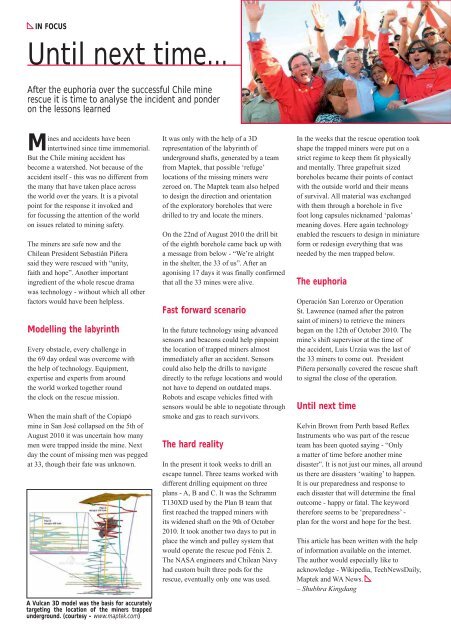Co-ordinates
Co-ordinates
Co-ordinates
You also want an ePaper? Increase the reach of your titles
YUMPU automatically turns print PDFs into web optimized ePapers that Google loves.
IN FOCUS<br />
Until next time…<br />
After the euphoria over the successful Chile mine<br />
rescue it is time to analyse the incident and ponder<br />
on the lessons learned<br />
Mines and accidents have been<br />
intertwined since time immemorial.<br />
But the Chile mining accident has<br />
become a watershed. Not because of the<br />
accident itself - this was no different from<br />
the many that have taken place across<br />
the world over the years. It is a pivotal<br />
point for the response it invoked and<br />
for focussing the attention of the world<br />
on issues related to mining safety.<br />
The miners are safe now and the<br />
Chilean President Sebastián Piñera<br />
said they were rescued with “unity,<br />
faith and hope”. Another important<br />
ingredient of the whole rescue drama<br />
was technology - without which all other<br />
factors would have been helpless.<br />
Modelling the labyrinth<br />
Every obstacle, every challenge in<br />
the 69 day ordeal was overcome with<br />
the help of technology. Equipment,<br />
expertise and experts from around<br />
the world worked together round<br />
the clock on the rescue mission.<br />
When the main shaft of the <strong>Co</strong>piapó<br />
mine in San José collapsed on the 5th of<br />
August 2010 it was uncertain how many<br />
men were trapped inside the mine. Next<br />
day the count of missing men was pegged<br />
at 33, though their fate was unknown.<br />
A Vulcan 3D model was the basis for accurately<br />
targeting 32 | <strong>Co</strong><strong>ordinates</strong> the location November of the 2010 miners trapped<br />
underground. (courtesy - www.maptek.com)<br />
It was only with the help of a 3D<br />
representation of the labyrinth of<br />
underground shafts, generated by a team<br />
from Maptek, that possible ‘refuge’<br />
locations of the missing miners were<br />
zeroed on. The Maptek team also helped<br />
to design the direction and orientation<br />
of the exploratory boreholes that were<br />
drilled to try and locate the miners.<br />
On the 22nd of August 2010 the drill bit<br />
of the eighth borehole came back up with<br />
a message from below - “We’re alright<br />
in the shelter, the 33 of us”. After an<br />
agonising 17 days it was finally confirmed<br />
that all the 33 mines were alive.<br />
Fast forward scenario<br />
In the future technology using advanced<br />
sensors and beacons could help pinpoint<br />
the location of trapped miners almost<br />
immediately after an accident. Sensors<br />
could also help the drills to navigate<br />
directly to the refuge locations and would<br />
not have to depend on outdated maps.<br />
Robots and escape vehicles fitted with<br />
sensors would be able to negotiate through<br />
smoke and gas to reach survivors.<br />
The hard reality<br />
In the present it took weeks to drill an<br />
escape tunnel. Three teams worked with<br />
different drilling equipment on three<br />
plans - A, B and C. It was the Schramm<br />
T130XD used by the Plan B team that<br />
first reached the trapped miners with<br />
its widened shaft on the 9th of October<br />
2010. It took another two days to put in<br />
place the winch and pulley system that<br />
would operate the rescue pod Fénix 2.<br />
The NASA engineers and Chilean Navy<br />
had custom built three pods for the<br />
rescue, eventually only one was used.<br />
In the weeks that the rescue operation took<br />
shape the trapped miners were put on a<br />
strict regime to keep them fit physically<br />
and mentally. Three grapefruit sized<br />
boreholes became their points of contact<br />
with the outside world and their means<br />
of survival. All material was exchanged<br />
with them through a borehole in five<br />
foot long capsules nicknamed ‘palomas’<br />
meaning doves. Here again technology<br />
enabled the rescuers to design in miniature<br />
form or redesign everything that was<br />
needed by the men trapped below.<br />
The euphoria<br />
Operación San Lorenzo or Operation<br />
St. Lawrence (named after the patron<br />
saint of miners) to retrieve the miners<br />
began on the 12th of October 2010. The<br />
mine’s shift supervisor at the time of<br />
the accident, Luis Urzúa was the last of<br />
the 33 miners to come out. President<br />
Piñera personally covered the rescue shaft<br />
to signal the close of the operation.<br />
Until next time<br />
Kelvin Brown from Perth based Reflex<br />
Instruments who was part of the rescue<br />
team has been quoted saying - “Only<br />
a matter of time before another mine<br />
disaster”. It is not just our mines, all around<br />
us there are disasters ‘waiting’ to happen.<br />
It is our preparedness and response to<br />
each disaster that will determine the final<br />
outcome - happy or fatal. The keyword<br />
therefore seems to be ‘preparedness’ -<br />
plan for the worst and hope for the best.<br />
This article has been written with the help<br />
of information available on the internet.<br />
The author would especially like to<br />
acknowledge - Wikipedia, TechNewsDaily,<br />
Maptek and WA News.<br />
– Shubhra Kingdang
















